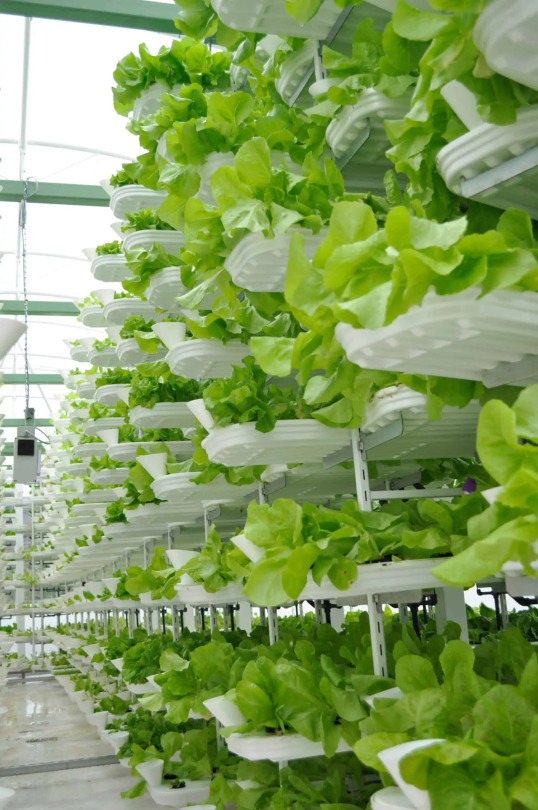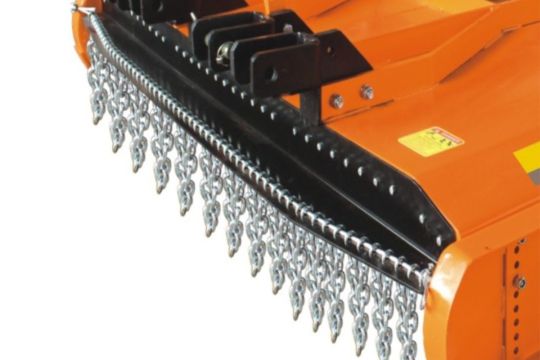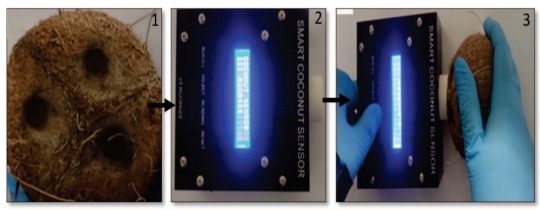#agriculture technology industry
Text
#agriculture technology as a service market#agriculture technology industry#artificial intelligence in agriculture report#iot in agriculture#bis research
0 notes
Text
From Japan to Iceland, futuristic vertical farms are starting to bloom

Indoor farming is a new and rapidly growing trend that has significant benefits over traditional agriculture methods, including increased efficiency and sustainability. Indoor farming can also help to combat climate change by reducing the amount of greenhouse gas (carbon dioxide, methane) released into the atmosphere and reducing the need for pesticides.
There are several different ways to do indoor farming, but the most common approach is to use hydroponic systems. These systems rely on water systems rather than soil to support plant growth, creating a controlled environment for the plants to grow in efficiently. An array of sensors designed specifically for this ensure that waste is minimized and resources are recycled whenever possible. Hydroponics also allows farmers to grow crops without dealing with pests or disease outbreaks, and it requires minimal land area compared to traditional agriculture methods. Because you essentially build the farm vertically, you can use places like former factories or warehouses.

In the Shizuoka Prefecture, a facility that’s around 20,000 square feet (0.2 hectares) grows a whopping 12,000 lettuces a day (lettuce is excellently suited for this type of farm). Farmers set up the light regime for the plants (using LEDs), as well as the temperature and humidity level, and enjoy round the year crops. Not only is the area required for the yield much lower than with conventional methods, but the water usage is also lower (10-20 times lower).
More recently, a farm in Kyoto developed by a company called Spread became a record-breaking facility that also introduced bees to pollinate its strawberries, achieving stable pollination under LED conditions and showing that there’s plenty of unexplored opportunity within vertical farms.Image credits: Spread.
Singapore is also betting on vertical farms with one farm established in 2022 producing 500 tonnes of greens each year, in addition to its previous projects. Being able to grow food directly in urban areas means you can bring it to consumers quickly and inexpensively.
Meanwhile, Iceland is taking advantage of its ability to produce cheap, sustainable energy using geothermal sources to fuel a large vertical farm. Iceland has constantly had a problem of having to import food, and Iceland has one of the most expensive food markets in the world due to this. But Andri Bjorn Gunnarsson, founder and CEO of VAXA, the company behind the vertical farm, says Iceland also has some advantages that make it suitable for vertical farming.
(Source: ZME Science, November 9th 2022)
#green#indoor farming#hydroponics#industrial farming#farming#green technology#japan#iceland#singapore#mine#articles#science#news#solarpunk#agriculture
95 notes
·
View notes
Text
Using a water-born crop that grows at breakneck speed, an innovative cattle feed startup could reduce livestock emissions in a variety of ways.
By reducing methane emissions from the bovine’s digestion, growing the plants on smaller lots than traditional feed, and using the farm’s manure to cover input costs, the aquatic feed offers protection to the invaluable beef industry from zealous politicians and activists who aren’t willing to wait for innovation to improve the carbon footprint of livestock.
Called Fyto, the startup boasts of a “library” of aquatic crop varieties that offer superior nutrition compared to other feeds like alfalfa.
27 notes
·
View notes
Text
“Cattle are disturbed by the same sorts of sounds as autistic people—high-pitched sounds, air hissing, or sudden loud noises; they cannot adapt to these,” Temple told me. “But they are not bothered by low-pitched, rumbling noises. They are disturbed by high visual contrasts, shadows or sudden movements. A light touch will make them pull away, a firm touch calms them. The way I would pull away from being touched is the way a wild cow will pull away—getting me used to being touched is very similar to taming a wild cow.” It was precisely her sense of the common ground (in terms of basic sensations and feelings) between animals and people that allowed her to show such sensitivity to animals, and to insist so forcefully on their humane management.
She had been primed to this knowledge, she felt, partly through the experience of her own autism and partly because she came from a long line of farmers and, as a child, had spent much of her time on farms. And her own mode of thinking allowed her no escape from these realities. “If you’re a visual thinker, it’s easier to identify with animals,” she said as we drove to the farm. “If all your thought processes are in language, how could you imagine that cattle think? But if you think in pictures . . .” Temple has always been a powerful visualizer. She was astonished when she discovered that her own near-hallucinatory power of visual imagery was not universal—that there were others who, apparently, had other ways to think. She is still very puzzled by this. “How do you think?” she kept asking me. But she had no sense that she could draw, make blueprints, until she was twenty-eight, when she met a draftsman and watched him drawing plans. “I saw how he did it,” she told me. “I went and got exactly the same instruments and pencils as he used—a 0.5-mm. HB Pentel—and then I started pretending I was him. The drawing did itself, and when it was all done I couldn’t believe I’d done it. I didn’t have to learn how to draw or design, I pretended I was David—I appropriated him, drawing and all.”
Temple constantly runs “simulations,” as she calls them, in her head: “I visualize the animal entering the chute, from different angles, different distances, zooming in or wide-angle, even from a helicopter view—or I turn myself into an animal, and feel what it would feel entering the chute.”
— An Anthropologist on Mars (Oliver Sacks, 1993)
#oliver sacks#temple grandin#an anthropologist on mars#psychology#autism#animals#animal welfare#animal behaviour#animal slaughter#meat industry#agriculture#farming#technology#engineering#sensory processing
14 notes
·
View notes
Text
According to a research report "Global Agriculture Industry Outlook 2024 - Feeding the Future Through Innovation" published by MarketsandMarkets, the Top 10 Agriculture Markets Will Grow From USD 81.5 billion in 2023 to USD 94.3 billion by 2024 at A YOY Increase of 15.7%.
#Global Agriculture Industry Outlook#Future of Agriculture Market#Future of Agriculture Industry#Agriculture Industry Outlook#The Future of Agriculture#AI in Agriculture the Future of Farming#Agricultural Production and Productivity Trends#Current and Future Trends in Sustainable Organic Farming#Agriculture 4.0#The Future of Farming Technology
0 notes
Text
Harvesting Machine Belts

Our Endless or Open Roll V Belts are specifically designed for crop harvesters of root vegetables and other plant harvesting machines. Primarily found in the produce of Radish, Carrots, Cabbage, Celery, Beets, Turnips, Parsnips, & Leek with a dirt hopper system, our V belts can also be found in use at flower and tree nurseries, as well as industrial harvest machine.
Depending on the application, our cord or ply structure machine belts will ensure low elongation and high tension to ensure the highest harvest yield. The high-wear rubber compounds have been designed to resist UV exposure and the harsh working conditions of inground harvesting.
If you manufacture conveyors for the food industry or are in need of one. You are in the right place. Rainbow Rubber & Plastics is one of the leading food conveyor belt suppliers in North America. We manufacture the highest quality food conveyor belts for grain and harvest machine belts.
#RainbowRubberPlastics#Reading#Pennsylvania#Conveyor Belts#Conveyor Belt Solutions#industrial machinery#industrial manufacturing#agriculture#agriculture technology
0 notes
Text
Bringing Renewable Energy to Local Farmers.

Eco-innovative farming solutions are vital to ensuring the
global reduction of greenhouse gas (GHG) emissions related to
agriculture. Biodôme du Maroc, a small, fast-growing Moroccan
company, provides local farmers with a technology that gives
them access to renewable energy for on-farm use.
Founded in 2013 by Dr. Fatima Zahra Beraich, Biodôme du Maroc
is the first Moroccan company to specialize in the recovery of
organic waste through natural treatment and environmentally
friendly processes. This is to enable farmers in rural areas to
produce biogas and fertilizer.

For the environment, biogas helps to reduce greenhouse gas
emissions from abandoned organic waste and minimizes the risk
of polluting waterways. This “clean” method of energy production
also reduces reliance on wood as a fuel source.
Biodôme du Maroc offers a range of small-scale agricultural
anaerobic digesters. These digesters use a simple and innovative
system to produce biogas and recover organic matter. Inside
underground concrete enclosures, farmers can deposit different
kinds of organic waste, such as household, plant and animal waste,
which is fermented in a biological accelerator. In this process, gas
is produced through methanization or anaerobic bio-digestion,
where bacteria naturally break down organic matter within weeks.

By providing a technology that produces gas from organic waste, Biodôme du Maroc gives local farmers access to renewable energy for agricultural production.
Dr. Beraich currently holds six patents covering innovations that
improve the efficiency and performance of Biodômeʼs bio-digesters.
“The process of securing a patent means that our technology
is evaluated by experts and allows us to understand just how
different our inventions are from other competing technologies.
This allows us to protect the inventive characteristics of our
outputs,” explains Dr. Beraich. “With these patents in hand, we
hope to be able to license our more recent patented innovations.”
The support of the Moroccan Association for Research and
Development (R&D Maroc) – part of the network of Technology and
Innovation Support Centers (TISCs) in Morocco – has played a critical role in the success of Biodôme du Maroc. “I learned about the TISC network at an outreach event at the University organized by the
Moroccan Industrial and Commercial Property Office,” Dr. Beraich
explains. R&D Maroc helped Dr. Beraich secure seed funding and also
ensured she had the help she needed to draft her patent applications, and license and access the technology she required to create and commercialize her bio-digesters. Biodôme is currently marketing its patent-protected bio-digesters in Morocco and across Africa.

#Eco-innovative farming solutions#worldipday#26 april#sdgs 12#sdg13#sdg11#sdg6#sdg7#ip and the sdgs#ip at work#sustainable agricultural#competing technologies#invention#patented technologies#patented innovation#Technology & Innovation#Innovation#r&d#Moroccan Industrial and Commercial Property Office#morrocco#bio-digesters#patent application#patent-protected
0 notes
Text
Global Research Analysis on "Agriculture Technology-as-a-Service Market" (2022-2027) | BIS Research

The agricultural landscape is undergoing a profound transformation, propelled by the integration of cutting-edge technologies. In this era of digitalization, Agriculture Technology-as-a-Service (ATaaS) has emerged as a revolutionary paradigm, redefining how farmers access and implement advanced technologies.
Let’s delve into the dynamic world of the Agriculture Technology-as-a-Service Market, exploring its key components, benefits, and the transformative impact on modern farming.
ATaaS: A New Dawn in Agriculture Sector
Agriculture Technology-as-a-Service represents a departure from traditional ownership models, offering farmers access to a suite of advanced technologies without the burden of high upfront costs. This subscription-based approach allows farmers to leverage state-of-the-art solutions, making precision agriculture more accessible and sustainable.
The Global Agriculture Technology-as-a-Service Market was valued at $1,606.9 million in 2022 and is expected to reach $3,438.6 million in 2027, with a CAGR of 16.43% during 2022-2027. The growth in the global agriculture technology-as-a-service market is expected to be driven by growing demand for precision agriculture solutions from small-scale farmers.
Key Components of Agriculture Technology as a Service Market
Precision Farming Solutions:
ATaaS provides access to precision farming technologies, including GPS-guided machinery, drones, and advanced sensors.
Precision agriculture enhances efficiency by optimizing resource usage, reducing waste, and improving overall farm productivity.
Data Analytics and Decision Support:
ATaaS integrates data analytics tools that provide farmers with actionable insights.
Decision support systems analyze vast datasets, offering guidance on crop management, irrigation, and pest control.
Remote Sensing Technologies:
Satellite imagery, drones, and other remote sensing technologies are integral to ATaaS.
Real-time monitoring of crops, soil conditions, and weather patterns empowers farmers to make informed decisions for timely interventions.
Request a Free Detailed Sample on Agriculture Technology-as-a-Service Market Research!
Benefits of Driving Adoption in the Industry
Cost-Efficiency:
ATaaS eliminates the need for significant upfront investments in technology.
Farmers can access cutting-edge solutions through a subscription model, reducing financial barriers to adopting advanced agricultural technologies.
Accessibility to Small Farmers:
Small and medium-sized farmers benefit from ATaaS, as it provides access to technologies that may have been financially out of reach.
This inclusivity fosters a more equitable distribution of technological advancements across the agricultural sector.
Flexibility and Scalability:
ATaaS offers flexibility in choosing services based on specific needs.
Farmers can scale their usage up or down, adapting to changing seasonal requirements and optimizing costs.
Challenges and Solutions
Data Security and Privacy:
The reliance on data-driven technologies in ATaaS raises concerns about data security and privacy.
Implementing robust cybersecurity measures and ensuring transparent data handling practices are essential to address these challenges.
Technological Literacy:
Farmers need to be technologically literate to fully harness the benefits of ATaaS.
Education and training programs play a crucial role in bridging the technological literacy gap and maximizing the impact of these services.
Future Outlook and Opportunities
The future of the Agriculture Technology-as-a-Service Market holds exciting possibilities. As advancements in technology continue, ATaaS is expected to play a pivotal role in shaping the next era of smart, sustainable, and efficient agriculture.
Conclusion
The Agriculture Technology-as-a-Service Industry signifies a shift towards a more inclusive and technologically empowered agricultural sector. As farmers embrace this subscription-based model, the synergy between accessible technology and modern farming practices promises a future where innovation and sustainability go hand in hand, transforming fields across the globe.
#Agriculture Technology-as-a-Service Market#Agriculture Technology-as-a-Service Report#Agriculture Technology-as-a-Service Industry#Agriculture Technology-as-a-Service Industry Analysis#Agriculture Technology-as-a-Service Market Growth#Agriculture Technology-as-a-Service Market Size#BIS Research#Agriculture
0 notes
Text
How to make edible cassava starch?
Recent years, edible cassava starch market grows rapidly, more people want to learn more edible cassava starch processing. Some people wonder that how to make ediblecassava starch:
Edible cassava starch processing is generally divided into home consumption and factory manufacturing. Their processing methods are similar and will be introduced in detail below.

Making edible cassava starch for home consumption is very simple. First, wash and peel the cassava, cut it into sections. After mashing it, add some water and let it settle for at least one night, and you will have wet starch. The wet starch is then dried in the sun to obtain edible cassava starch.
Another is factory manufacturing edible cassava starch.There are 3 parts in edible cassava starch processing, cleaning, processing and drying.

Cleaning part:
Fresh cassava tubers harvest from farm, will meet 2 stages cleaning, one is dry sieve to do simple cleaning to remove some grass and impurities. Then cassava enter paddle washing machine cleaning again.

Processing part:
After cleaning, fresh cassava need be grating. The grating rate can influence final starch yield. Some people focus on grating machine configuration. Now the high configuration include cutting machine and rapser machine together, grating rate will over 96%.
After grating, fibers and proteins will be separated from cassava slurry by centrifugal sieve machine and hydrocyclone. Different edible cassava starch usage will influence machine list. Engineer will design different stages according clients’ requirements.
Next step will be dewatering, cassava slurry enter dewatering machine to remove moisture to about 38%.

Drying part:
After removing moisture, finally is drying and package. The airlflow flash dryer will dry edible cassava starch in the short drying time. Last, sifter sieve and packing machine will help to get finer edible cassava starch and pack to sale.
As a professional cassava machine supplier, Henan Jinrui Food Company owns much experienced technical team.
We can be designed with different configuration edible edible cassava starch machines with client’s budget and requirement. If you want to learn more information, we are welcome getting your inquiry.
#cassava#africa#technology#agriculture#industry#business#marketing#jobs#economy#medium#innovation#ai art#3d
0 notes
Text
Fieldking Rotary Cutters: Precision in Every Pass

Experience precision and efficiency with Fieldking's rotary cutters. Tailored for diverse cutting needs, our rotary cutters deliver exceptional performance in fields of all sizes. Designed for durability and ease of use, Fieldking ensures that every pass is a testament to quality.
From clearing brush to maintaining pastures, our rotary cutters are the go-to solution. Invest in Fieldking's cutting-edge technology and witness the difference in your land management practices. Transform your cutting tasks with the reliability of rotary cutters.
#rotary cutter#rotary cutters#agriculture equipment#agriculture machinery#agriculture technology#farming tools#farm equipment#farming industry
0 notes
Text
'Smart Coconut Sensor' for Quality Assessment
'Smart Coconut Sensor' for Quality Assessment
@neosciencehub
#neosciencehub #science #research #IInvenTive2024 #IITRoorkee #QualityAssessment #SmartCoconutSensor #PlantMolecularBiology #coconut #India #CoconutIndustry #QualityControl #Agriculture
IIT Roorkee Unveils at IInvenTive 2024
The Indian Institute of Technology Roorkee, at the IInvenTive 2024, introduced a significant advancement in agricultural technology with the ‘Smart Coconut Sensor.’ This innovative device, developed by the Plant Molecular Biology Group from the Department of Biosciences and Bioengineering, led by PratibhaDemiwal, Rittika Ray, and spearheaded by…

View On WordPress
#Agricultural Innovations#Coconut Industry#featured#IInvenTive 2024#IIT Roorkee Research#Non-Invasive Technology#Quality Control in Agriculture#research#sciencenews
0 notes
Text
Money on the Vine: Growing Agricultural Revenue in New Directions
In this article, we will explore the potential for cultivating diverse streams of income within the agricultural sector, steering away from conventional practices and embracing pioneering ventures. The concept of ‘money on the vine’ takes on a new significance in light of the shifting consumer preferences and market demands, prompting farmers and agri-entrepreneurs to explore unconventional paths to profitability. From agro-tourism and value-added products to agritech and sustainable practices, the opportunities for diversifying income are vast and promising.
As the world of Best agriculture . continues to undergo significant changes, the traditional methods of generating revenue are being reimagined. This evolution has given rise to innovative approaches that intersect agriculture and commerce, opening up new avenues for revenue growth. (https://bestagriculture.org/2023/11/15/money-on-the-vine-growing-agricultural-revenue-in-new-directions/ )
In…

View On WordPress
#aagriculture#Advantages of Agriculture#Agribusiness#agricultural#agricultural communities#Agricultural Education#Agricultural Export Opportunities#Agricultural Industry#Agricultural Marketing#Agricultural Practices#Agricultural Research#Agricultural Technology#Agricultural Tourism#Agricultural Trends#Agriculture#Agriculture Business#agriculture business plan#Agriculture Education#Agriculture Features#Agriculture for a Better Future#arable farmer#Benefits of Agriculture#effects of modern agriculture#farm#Farmer#Farmer-Crop#farmers#Farmers Market#farming#Farming Challenges
1 note
·
View note
Text
Exploring the Future of IoT | Internet of Things
Internet of Things (IoT) has already transformed the way we perceive and interact with technology connecting everyday objects to the digital world. As we navigate through a rapidly evolving technological landscape it becomes crucial to delve deeper into the future of IoT and the endless possibilities it holds. Let’s explore the exciting advancements and emerging trends that will shape the future…

View On WordPress
#connected devices#Data Analytics#Emerging IoT Technologies#Future Technology#Industrial IoT#IoT Applications#IoT Automation#IoT Connectivity#IoT Data Privacy#IoT Ecosystem#IoT in Agriculture#IoT in Healthcare#IoT Industry Insights#IoT Infrastructure#IoT Innovations#IoT Security#IoT Sensors#IoT Sustainability#IoT Trends#Smart Homes
0 notes
Text
Agriculture has come a long way since its humble beginnings, evolving into a highly sophisticated and technology-driven industry.
The global imaging technologies for precision agriculture market size was $885.0 million in 2022, and with a CAGR of 11.27%, it is expected to reach $1,690.6 million by 2028.
The adoption of imaging technologies in agriculture is driven by multiple factors. Firstly, the need for precision and efficiency pushes farmers to optimize their agricultural practices by utilizing data-driven insights from imaging technologies, enabling them to identify crop health issues and apply targeted treatments.
#Imaging Technologies for Precision Agriculture Market#Imaging Technologies for Precision Agriculture Report#Imaging Technologies for Precision Agriculture Industry#Agriculture#BISResearch
0 notes
Text
Biotechnology Assignment Help
Biotechnology is a rapidly evolving field that manipulates living organisms using precise scientific methods, finding extensive applications in industries like cosmetics, pharmaceuticals, agriculture, and food production. It drives innovation and commercial development, offering diverse career paths. Graduates often find opportunities in pharmaceuticals, focusing on drug discovery and testing. They also contribute to food production, preservation, and waste management. Bio-energy presents environmental solutions, while genetics and stem cells play pivotal roles in medical and high-tech sectors. Bioinformatics and bioethics impact policy and nonprofit organizations. To excel, students seek Biotechnology Assignment Help services, as this multidisciplinary field demands a deep understanding of genetics, chemistry, and neuroscience, progressing to advanced topics such as bioinformatics and bioprocessing. Reliable assistance is available, ensuring high-quality, plagiarism-free assignments from experienced professionals within budget constraints. Access to samples, revisions, and research guidance enriches the learning experience.

#Biotechnology#Science#Technology#Pharmaceutical#Industry#Agriculture#Food Production#Bio-Energy#Genetics#Bioinformatics#Assignment Help#Multidisciplinary
0 notes
Text
How Does Seed Treatment Help in Improving Yield?
Seed treatment can be defined as the application of insecticide, fungicide, or both to seeds to disinfect them from soil-borne or seed-borne pathogenic organisms or storage insects. It refers to seeds subjected to immersion in conditioned water, solar energy exposure, or others.
The seed treatment helps in preventing the spread of plant diseases. It protects seeds from seedling blights and seed rot. In addition, seed treatment improves germination, ensures protection from storage insects, and controls soil insects.

Methods for Seed Treatment
Seed Dressing: Seed dressing is the most common method for seed protection. In this way, the seed is dressed with either a dry formulation or wet treatment with a liquid formulation or slurry. Dressings need to be applied in both industries, and farms. This process involves, spreading the sheet on a polyethylene sheet, and needs several chemicals for sprinkling on surface seeds.
Seed Coating: The seed coating method is primarily utilized in industries. It involves advanced treatment technology.
Seed Pelleting: It is a method utilized for transforming the physical shape of the seed to improve palatability. This process involves sophisticated seed treatment technology.
The seed treatment industry is projected to rise in the coming years. It is ascribed to surging government initiatives, and efforts of private organizations to enhance the crop yield, with increasing application of technologically advanced seed treatment solutions for improving the seed quality, and growing requirement for basic grains and vegetables, led by increasing population.
Under the crop type, cereals and grains capture the largest industry share, in terms of both value, and volume. It is ascribed to the massive-volume production of cereals and grains, including wheat, rice, corn, ragi, barley, and sorghum, led by increasing consumption and surging per capita income.
Under the application method segment, the dressing category holds the largest volume and revenue shares. It is ascribed to the rising usage of dressings as dry formulations, wet-treated slurry, and liquid formulation applications.
Under the application time segment, the pre-treatment category captures the largest industry share, in terms of both revenue and volume. It is ascribed to the rising adoption by the manufacturer for the protection of seeds from soil-borne, and seed-borne diseases.
APAC captures the largest industry share, and it is projected to follow the same trend in the coming future. It is ascribed to the high-volume crop production in countries, such as Vietnam, South Korea, India, China, and Australia. Furthermore, these countries employ more seed protection products to improve yield.
#seed treatment#agriculture industry#market analysis#seed treatment technology#agricultural innovations#market trends#crop protection#seed coating#pest control#agricultural advancements#market dynamics#seed treatment solutions#sustainable agriculture#crop enhancement#seed treatment market outlook
0 notes